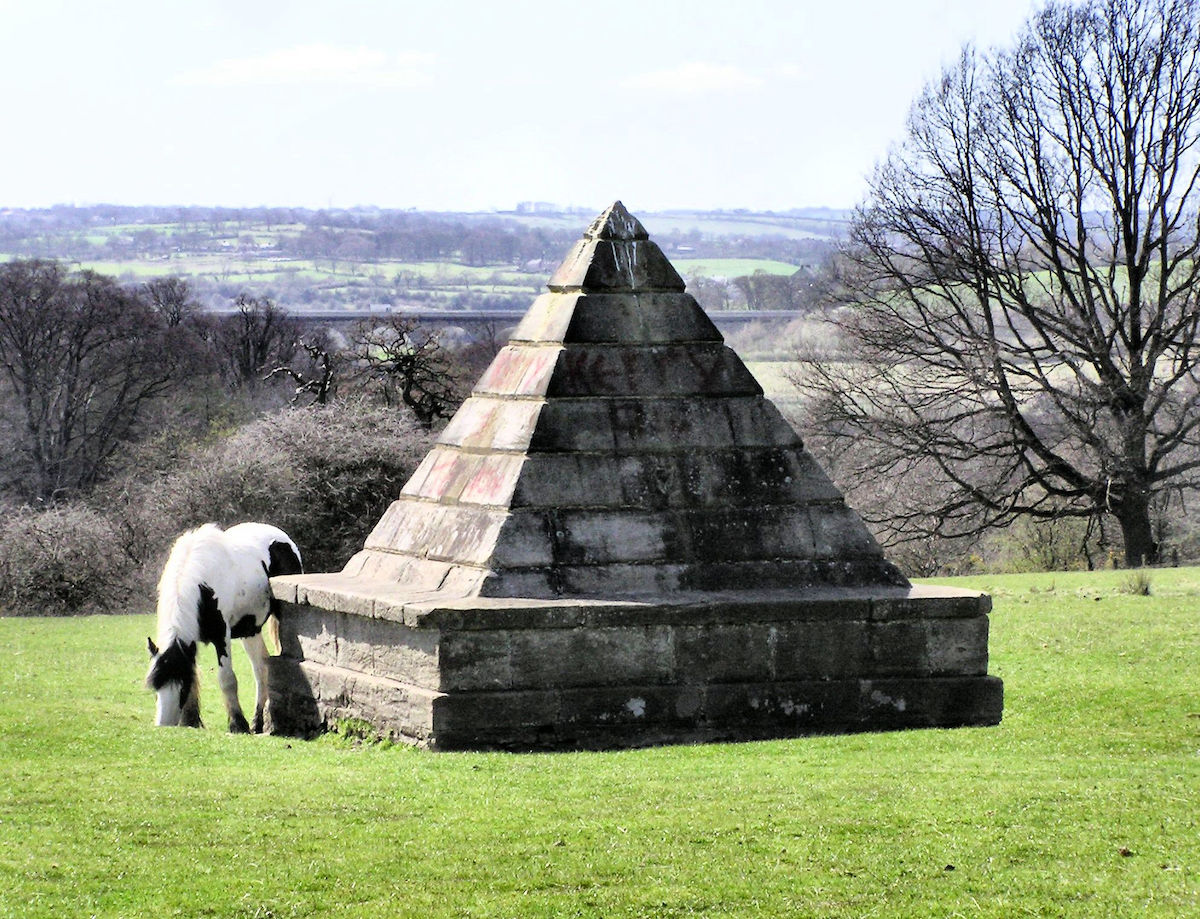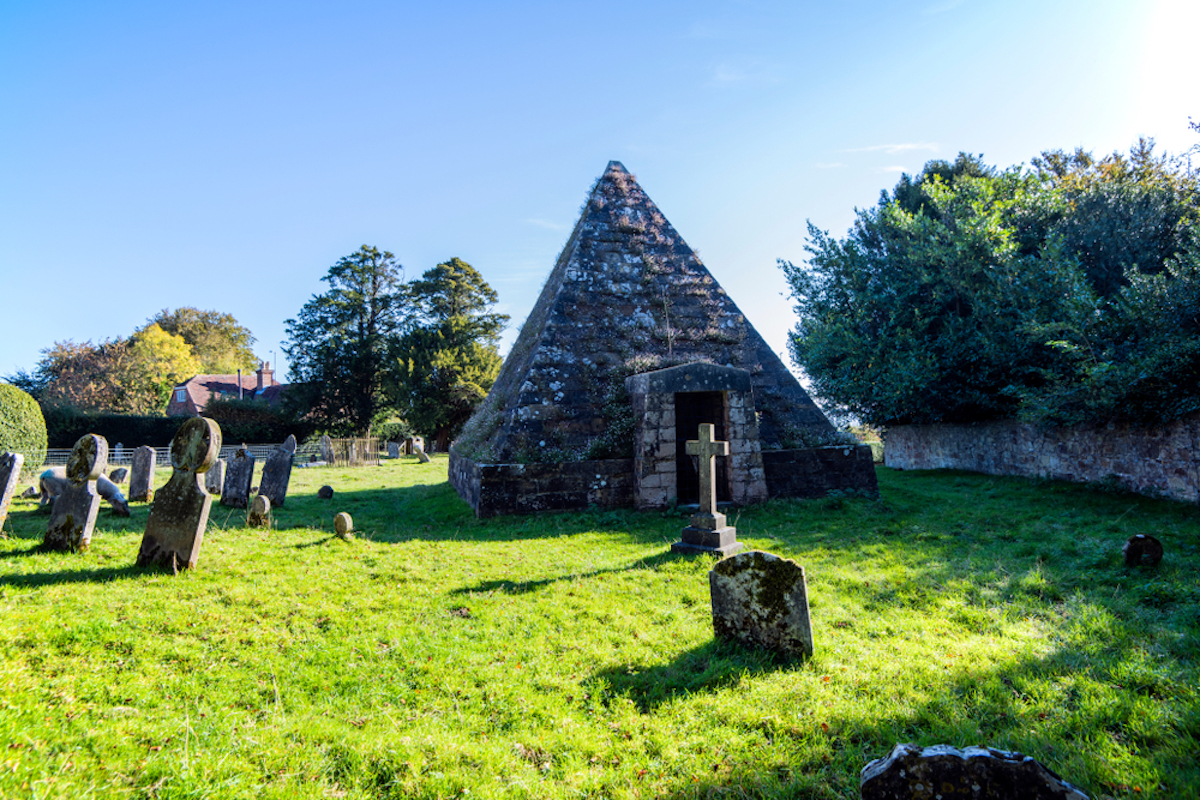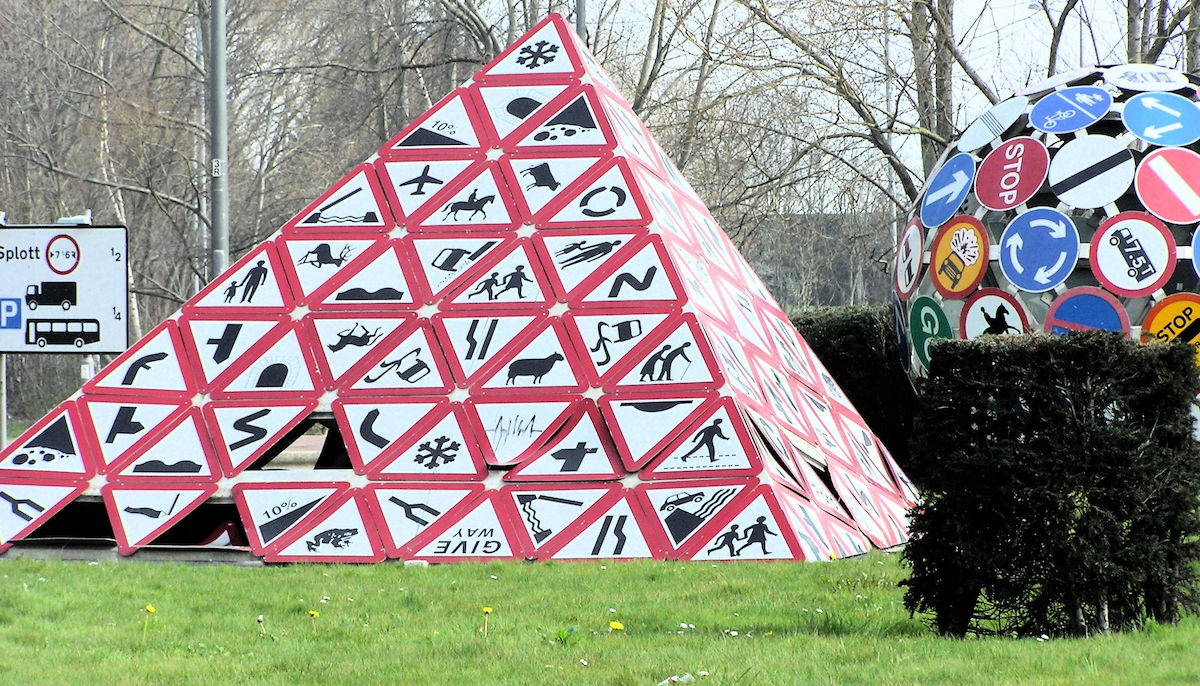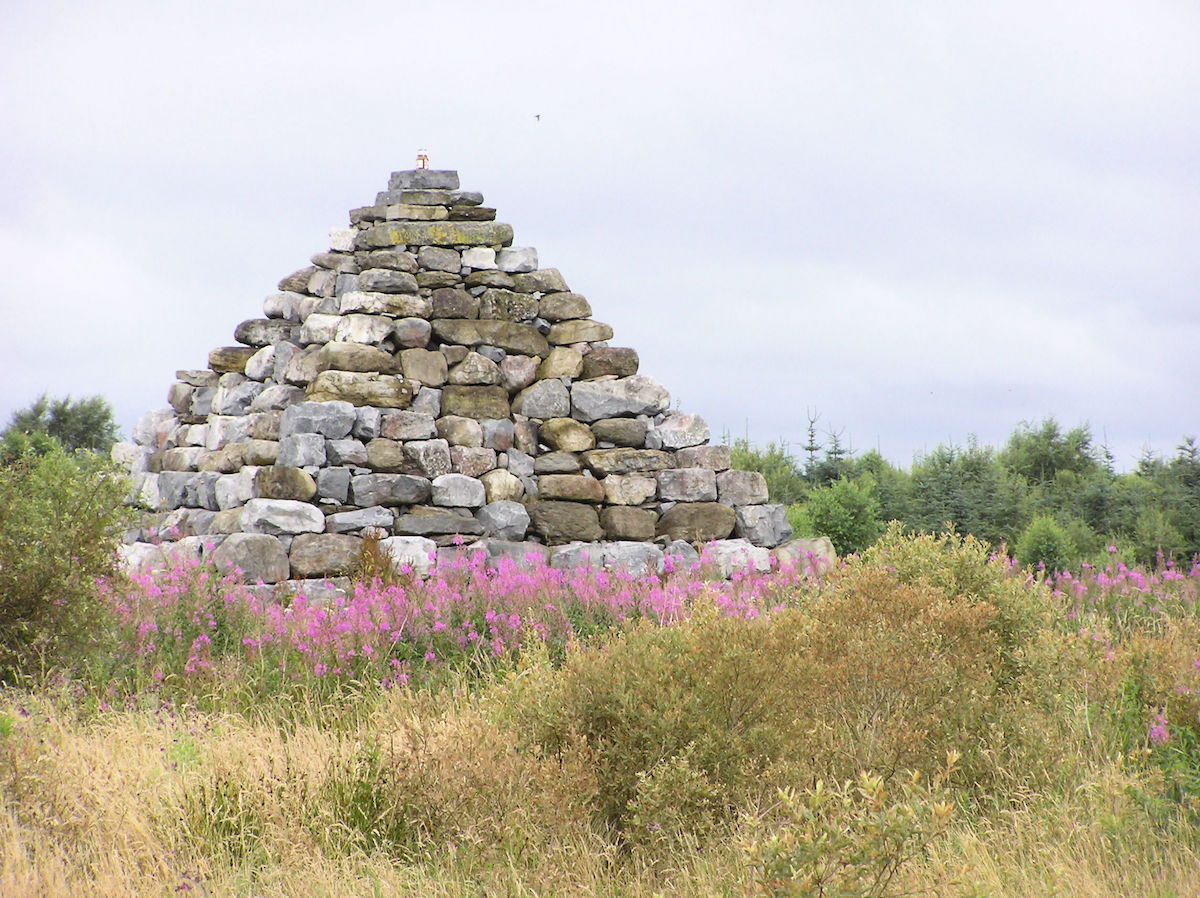This wonderful Cornish workshop and museum is dedicated to the legacy of studio pottery trailblazer Bernard Leach
Become an instant expert on…the pyramids of Britain and Ireland
Become an instant expert on…the pyramids of Britain and Ireland
17 Jul 2023
We associate pyramids with all things Egyptian, Mesopotamian or Mayan, but think again says David Winpenny. Follow his trail this summer and discover the cone-shaped curiosities that lie closer to home
Soaring pyramids in an Egyptian scene in Excavation of the Sphinx, 1887, by Ernst Karl Eugen Koerner. Image: © Christie's Images/Bridgeman Images
‘…from the summit of these Pyramids, 40 centuries look down upon you’
Napoleon Bonaparte addressing his troops in Egypt, 1798
The Tomb of Gaius Cestius, Rome (the Pyramid of Cestius) by Jean Jacques François Le Barbier (1738–1826). Image: Bridgeman Images
1. From Egypt to Glastonbury
We all recognise a pyramid – it’s one of the most basic geometrical solids. We almost certainly made them messily from cardboard when at school.
Yet did we know pyramids might have developed from the idea of the ‘Magic Mountain’, raised by our ancestors to reach the gods and (by logical development) to bury their great leaders?
The pyramids were already ancient when the Romans invaded Egypt in 30 BC. Those invaders took the Egyptian gods into their own pantheon – and copied the pyramids. Several were constructed in ancient Rome. Today only the Pyramid of Cestius remains – a tour de force that was a great influence on the wealthy young men from Britain and Europe who, in the 18th century, were on their Grand Tours.
They took the idea of pyramids, both as monuments and quirky landscape features, back to their estates. There they began to build them – often copying the narrower Cestius profile, rather than the Egyptian.
There was a spur to this activity with the developing rite of Freemasonry, with its acknowledgement of a mystical Egyptian past, and some British pyramids have Masonic elements. A further fillip came when Napoleon invaded Egypt in 1798; he ordered close examination and publication of Egyptian antiquities, which inspired a wave of Egyptianising throughout Europe.
The later 19th century had little use for pyramids, except occasionally as grave markers. But by the later 20th, and now 21st century, the pyramid shape has had a resurgence. Its efficient, satisfying shape pleases today’s designers: witness architect IM Pei’s glass and metal Louvre Pyramid, at the entrance to the Louvre in Paris, and the affection with which the Pyramid Stage at Glastonbury Festival is held.
 Pyramid or reservoir marker? The landmark rusticated pyramid at Auckland Castle. Image: Courtesy of David Winpenny
Pyramid or reservoir marker? The landmark rusticated pyramid at Auckland Castle. Image: Courtesy of David Winpenny
2. Noteworthy peaks
Architects Sir John Vanbrugh and Nicholas Hawksmoor were among the first in Britain to place pyramids as ornaments in the landscape.
At Castle Howard in Yorkshire they created several, including the Pyramid Gatehouse of 1719 and the Pyramid on St Anne’s Hill of 1728, both intended to impress visitors as they approached the Earl of Carlisle’s grand estate. It’s thought those pyramids may have had Masonic meaning too.
Heading to Nottinghamshire, it was patriotic feeling that inspired the Nelson Pyramid at Perlethorpe cum Budby. The man behind it was the owner of Thoresby Estate, a naval officer, who had it built after Nelson’s heroic victory at the Battle of the Nile in 1798. Another pyramid with a tale of warfare comes with Britain’s oldest example, Compton Pike in Warwickshire. It is thought to have been built in defence of the country, as the site of a beacon to warn of the landing of Spaniards, at the time of the Armada in 1588.
From war to water, some pyramids usefully mark water sources. The stepped pyramid at Halswell Park in Somerset is a perfect example: it covers a spring and is even dedicated to a ‘pure nymph’. At Auckland Castle, Co Durham, once home to powerful Prince Bishops of Durham, the site of a reservoir is capped with an 18th-century rusticated pyramid (seen above). And at Stanway House in Gloucestershire, a pyramid folly of 1750 sits above a cascade and the world’s highest gravity-fed fountain. Look out, too, for pyramidal navigation marks, like those on Holy Island, at Porthcurno in Cornwall, and that overlooking the Swellies, a particularly strong current with a fiercesome reputation on the Menai Strait.
Pyramids have also been created to commemorate special events.
There is a pyramid (the Bagot Memorial) built to salute forestry planting at Clocaenog in Denbighshire (complete with an Eric Gill inscription). Another marks the site of the death, in 1815, of the 21-year-old Duke of Dorset in a hunting accident at Ballybrack, near Dublin. And there is a pyramid folly built as the final resting place of a remarkable horse, known as ‘Beware Chalk Pit’. The horse gained the moniker after surviving (with his rider) a dive into a 25-foot chalk pit in 1733. You’ll find his pyramidal memorial at Farley Mount near Winchester.
 ‘Mad Jack’ Fuller’s pyramid at Brightling in Sussex. Image: Shutterstock
‘Mad Jack’ Fuller’s pyramid at Brightling in Sussex. Image: Shutterstock
3. Prime views
Commemorating the dead was a prime focus for past British and Irish pyramid builders, with pyramid-topped mausolea being hugely popular.
Architect James Wyatt designed two impressive examples: at Cobham in Kent, where the Darnley Mausoleum has recently been triumphantly restored, and at Kilbixy, County Westmeath in Ireland. The mausoleum at Gosford Park in East Lothian is thought to have been designed by Robert Adam. And at Blickling Great Wood in Norfolk, on the Blickling Hall estate, the pyramid for the Earl of Buckinghamshire was designed by Italian architect Joseph Bonomi, whose son was a noted Egyptologist.
Beautifully located commemorative pyramids include that erected for the Clan Cahil O’Donovans, at Myross on the Cork coast, overlooking the wild Atlantic waves. Others are to be found in tranquil country graveyards, like ‘Mad Jack’ Fuller’s monument at Brightling in East Sussex, in the churchyard of St Thomas à Becket. Fuller, a politician and eccentric, built a number of follies. One legend says that, on his death in 1834, he was placed in his pyramid sitting at a table surrounded by broken glass so the devil couldn’t claim him. As an aside, that pyramid, known as Brightling Mausoleum, was designed by a young Robert Smirke, who went on to design the British Museum.
In the churchyard of St Andrew at Nether Wallop, near Stockbridge, you’ll also find a pyramid, this one topped by a flame carved in stone. It was ordered by another eccentric, the 18th-century physician Dr Francis Douce, who gave money to educate local children (but not too much for the girls, apparently, ‘lest it make them saucy’).
Back in Ireland there are some fine pyramids, possibly all by just one, anonymous, designer. At Kinnitty, County Offaly, there is one for the Barnard family, a made-to-scale replica of the Great Pyramid of Giza. And at Naas, County Kildare, uniquely, two large pyramids occupy the Maudlins Cemetery; nowhere else in the British Isles are two large pyramids in such close proximity, and the story behind them is not fully known.
Perhaps the most majestic of Britain’s pyramids commemorates Prince Albert, high on Creag an Lurachain above Balmoral Castle. This was Queen Victoria’s personal tribute to her husband. Climb up to it and you’ll be rewarded with views overlooking the panoramic length of the River Dee.
 A pyramid of road signs, Cardiff. Image: Courtesy of David Winpenny
A pyramid of road signs, Cardiff. Image: Courtesy of David Winpenny
4. Follies and eccentricities
Some pyramid builders have struck out on their own.
Two modern architects have even provided concrete pyramids. Leonard Manasseh, one of the architects involved in the Festival of Britain, was behind one in 1958, placed outside what is now King Solomon Academy in Marylebone, London, as part of a sculpture garden for the children. Basil Spence, who created Coventry Cathedral, designed a poured-concrete gallery and boathouse topped by a pyramid for the former Carmel College in Oxfordshire between 1969 and 1970.
Two centuries earlier the wealthy George Durant II of Shropshire built two brick pyramids on the estate he inherited – Tong Castle. There was a tall one for hens, known as the Egyptian Aviary, and one built as a pigsty, inscribed ‘To please the pigs’. They survive, on farms on the estate, while the mighty Tong Castle is long gone, to make way for the M54.
At Hampstead Norreys, Berkshire, in the graveyard of St Mary, you’ll find Britain’s only cast-iron pyramid, made of recycled agricultural implements and commemorating the Lowsley family (some with curious first names, such as Barzillai and Oded).
Also unique is Dundee’s formica pyramid, commissioned in 1983 and sitting above a disused public lavatory. It was designed by a local art student, Stan Bonnar, as part of a local arts programme. Another pyramid built as part of an arts venture, and made of unusual materials, is the pyramid of triangular road signs on the Ocean Way in Cardiff. Erected in 1990, it accompanies other road sign sculptures on what is known as the Magic Roundabout.
 Sculptor Eileen MacDonagh's Boora Pyramid in the peaty landscape of County Offaly. Image: Courtesy of David Winpenny
Sculptor Eileen MacDonagh's Boora Pyramid in the peaty landscape of County Offaly. Image: Courtesy of David Winpenny
5. Losses and survivals
As evidence shows, we’re blessed with the survival of fascinating pyramids in Britain and Ireland, but some have met with unhappy fates.
Take the pyramid swimming pool at Bletchley. It was built with unusual materials: the whole structure, designed in 1974 by Harry Faulkner-Brown and team, was formed, fractal-like, of small, smoky-brown plastic pyramids. It was an important early manifestation of the leisure centre – but was refused listing protection and demolished in 2009.
Another that could meet the same fate is The Point at Milton Keynes, a red-painted steel framework pyramid over Britain’s first multiplex cinema. Opened in 1985, it too has been denied listing and could be removed.
Other modern pyramids survive through new uses. At just over 120 feet, the blue pyramid in Stockport, often called the ‘Stockport Pyramid’, is Britain’s biggest. Completed in 1992, it housed the Co-operative Bank for years and has recently been refurbished as modern offices.
Not long after the blue pyramid came Ireland’s major modern pyramidal building – the award-winning visitor centre at the archaeological site of Céide Fields, high on the cliffs of County Mayo. It opened in 1993 to interpret the 5,000-year-old prehistoric agricultural landscape; the centre’s designer, Mary McKenna, linked its shape with magic mountains and in particular Ireland’s holy mountain, Croagh Patrick.
A final example, also with links to the past, can be found at Lough Boora in the bleak peatlands of County Offaly, where a permanent collection of innovative sculptures can be found on the land. Early this century sculptor Eileen MacDonagh built Boora Pyramid there, a stepped structure made of glacial stones from the landscape, as part of the public sculpture programme. She wrote of it as having ‘resonance with previous times and cultures’. It makes this pyramid just one of the latest – though others are following – in our history of pyramidal structure in Britain and Ireland.
David’s top tips
Keep a lookout
Once you get your eye in, you’ll see pyramids everywhere.
If you want to go hunting, National Trust properties are a good place to start. Try the following:
- Blickling: nationaltrust.org.uk/visit/norfolk/blickling-estate
- Porthcurno: nationaltrust.org.uk/visit/cornwall/porthcurno
- Nostell: nationaltrust.org.uk/visit/yorkshire/nostell
- Cobham Mausoleum: nationaltrust.org.uk/visit/kent/cobham-wood-and-mausoleum
- Wentworth Woodhouse: nationaltrust.org.uk/visit/yorkshire/houses-buildings/visit-wentworth-woodhouse
-
Stowe: nationaltrust.org.uk/visit/oxfordshire-buckinghamshire-berkshire/stowe
Great reads
Tales of pyramids feature in books on follies and monuments, including:
Follies & Grottoes by Barbara Jones (Constable, 1974)
The Follies and Garden Buildings of Ireland by James Howley (Yale University Press, 1993)
Follies, Grottoes & Garden Buildings by Gwyn Headley and Wim Meulenkamp (Aurum Press, 1999)
Follies of Europe: Architectural Extravaganzas, text by Caroline Holmes, photographs by Nic Barlow, introductory text by Tim Knox (Garden Art Press, 2008)
My own book, Up to a Point: In Search of Pyramids in Britain and Ireland, is the only book on the pyramids of Britain and Ireland. Find out more at davidwinpenny.co.uk
For more on the Egyptian Revival:
The Egyptian Revival by James Stevens Curl (George Allen & Unwin, 1982)
The Egyptian Revival: Its Sources, Monuments and Meaning 1808–1858 by Richard G Carrott (University of California Press, 1978)
Imhotep Today: Egyptianizing Architecture edited by Jean-Marcel Humbert and Clifford Price (UCL Press, 2003)
Egypt in England by Chris Elliott (English Heritage, 2012)
If you enjoyed this Instant Expert why not forward this on to a friend who you think would enjoy it too?
Show me another Instant Expert story – theartssociety.org/instant-expert
The images for points 2, 4 and 5 are courtesy of David Winpenny.
About the Author
David Winpenny
is a writer and a lecturer with a passion for architectural history, particularly its more curious side. Among his published works, including his book on pyramids (see above), are a guide to Northumbria and books of walks. He has also had features published in titles such as BBC Countryfile Magazine and newspapers including The Times, The Independent and The Daily Telegraph. David’s current talks for The Arts Society include Eccentrics, exotics and erratics: buildings in gardens; Nijinsky’s camel: Gladys, Countess de Grey, champion of the arts; Opening the doors: a brief history of country house visiting; Coronation: majesty, myth, music – the development of a national ritual and Up to a point: in search of pyramids in Britain and Ireland.
Article Tags
JOIN OUR MAILING LIST
Become an instant expert!
Find out more about the arts by becoming a Supporter of The Arts Society.
For just £20 a year you will receive invitations to exclusive member events and courses, special offers and concessions, our regular newsletter and our beautiful arts magazine, full of news, views, events and artist profiles.
FIND YOUR NEAREST SOCIETY
MORE FEATURES
Ever wanted to write a crime novel? As Britain’s annual crime writing festival opens, we uncover some top leads
It’s just 10 days until the Summer Olympic Games open in Paris. To mark the moment, Simon Inglis reveals how art and design play a key part in this, the world’s most spectacular multi-sport competition


